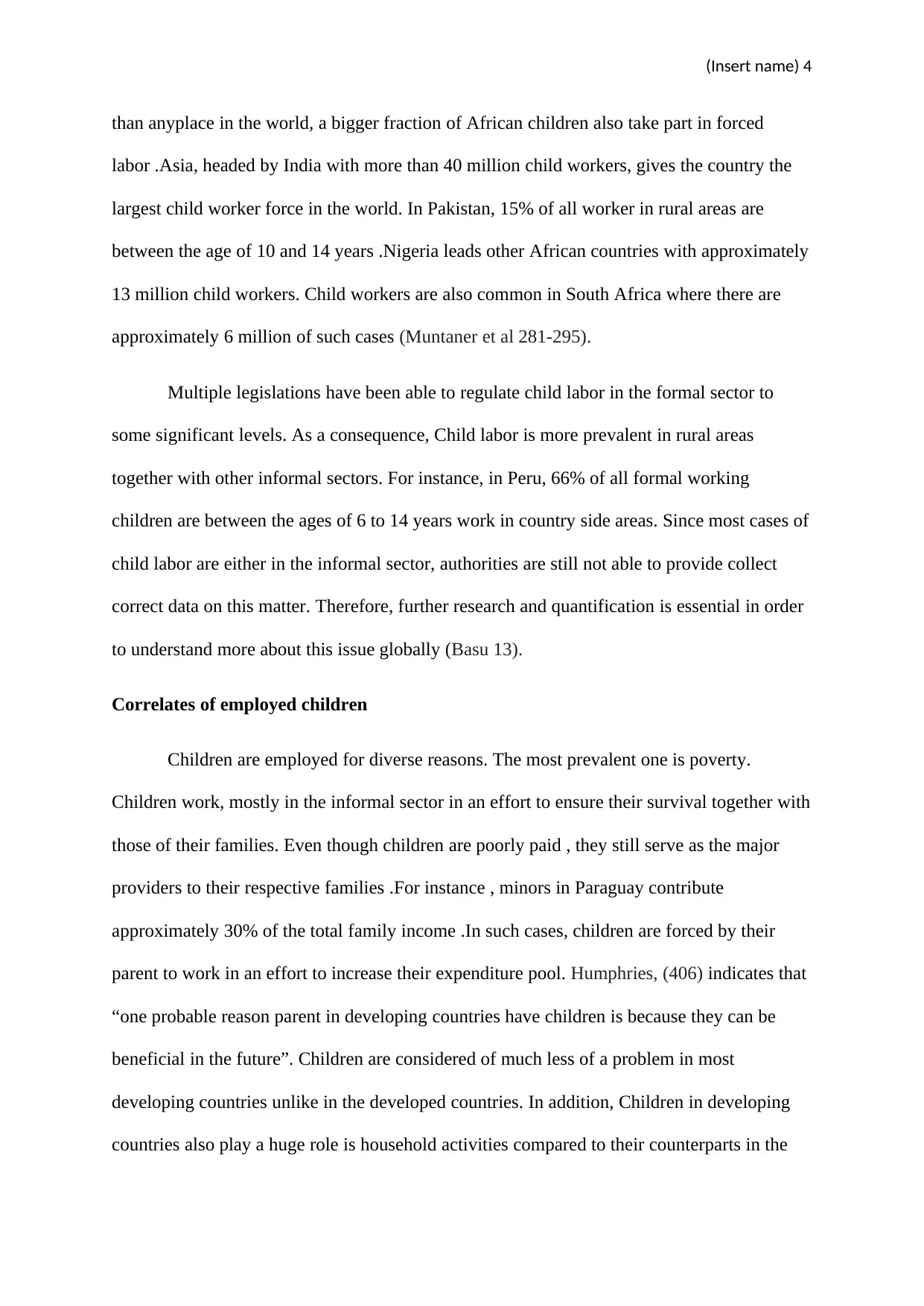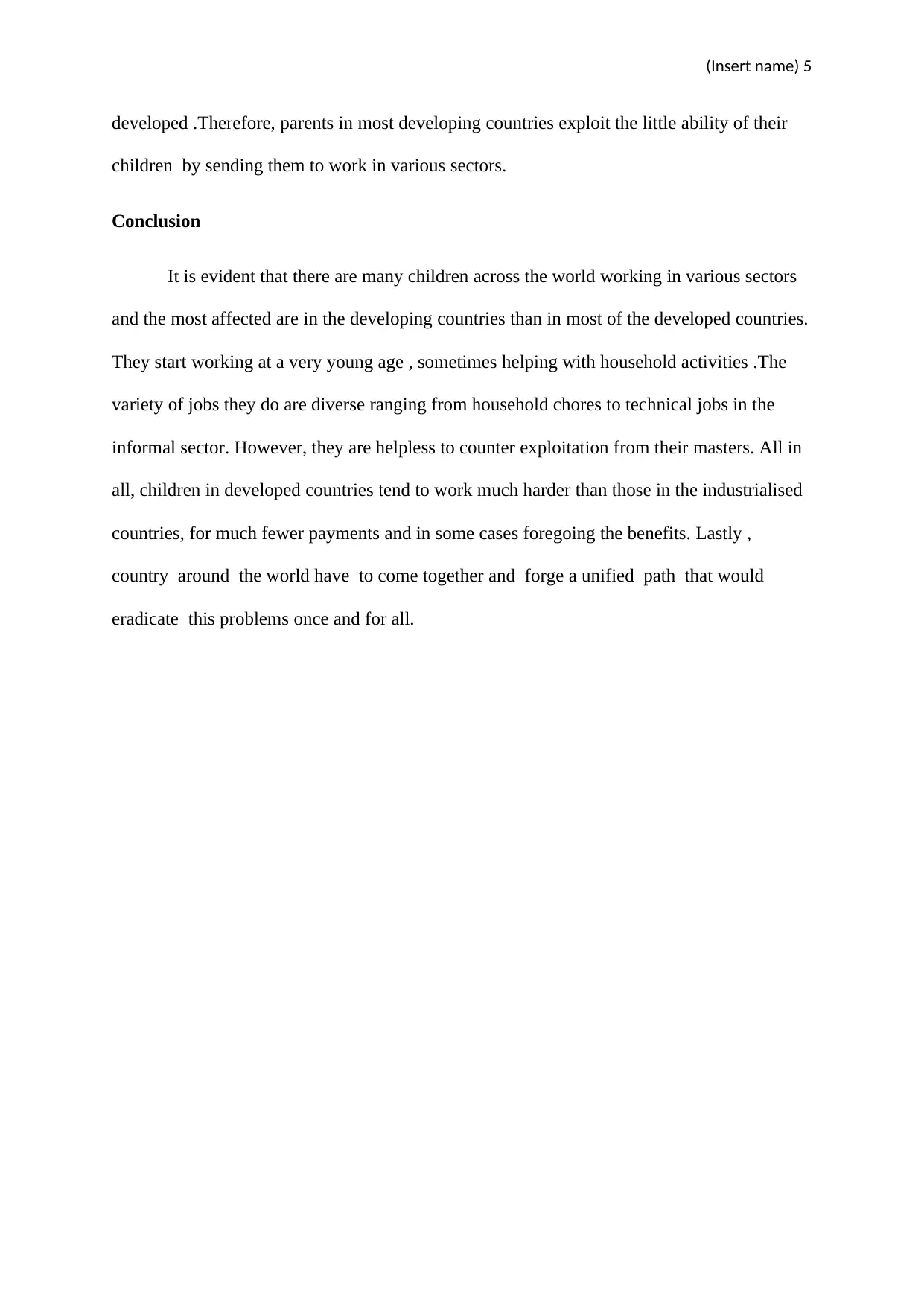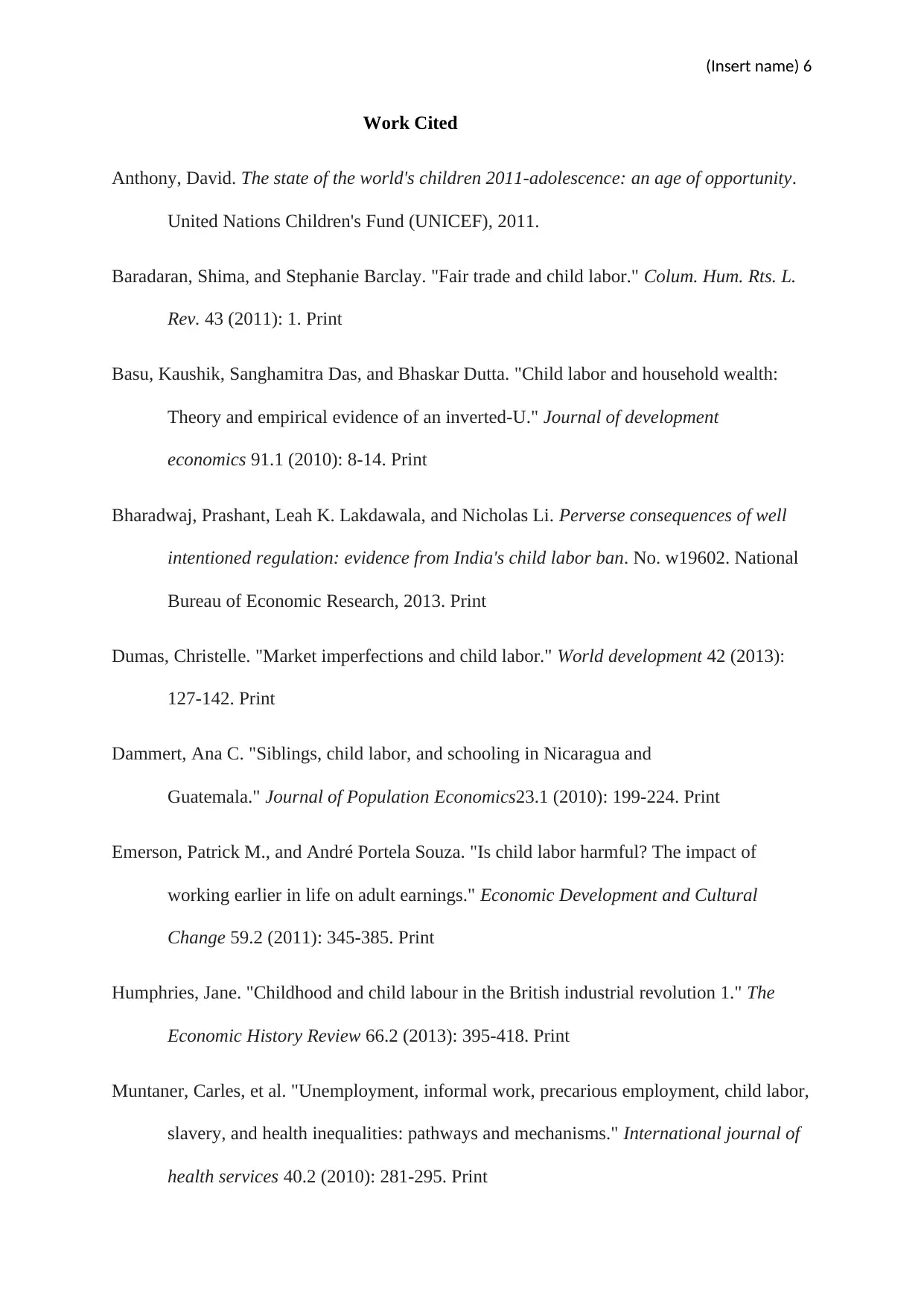Understanding Child Labor: Key Features, Causes, and Global Impact
VerifiedAdded on 2023/04/19
|7
|1897
|277
Essay
AI Summary
This essay provides a comprehensive analysis of child labor, defining it as the exploitation of children aged 6-17 in ways that deny them their childhood and education. It highlights the interconnectedness of poverty and child labor, where financial constraints force families to prioritize immediate income over long-term education. The essay examines the causes of child labor, primarily poverty, lack of quality education, and credit constraints, and discusses the challenges in eradicating it due to varying definitions and regulations across nations. It also presents statistics on child labor prevalence in developing countries, particularly in Asia and Africa, and concludes by emphasizing the need for a unified global approach to eliminate this issue, advocating for international cooperation to protect vulnerable children from exploitation and ensure their access to education and a better future. Desklib is a platform where students can find similar essays and solved assignments.

(Insert name) 1
Student’s Name
Course
Professor’s Name
University
Date
Child labor
Child labor can be described as the recruitment of children between the age of 6 and
17 years old in any form of employment that denies them their childhood or interfere with
their capacity to join school and that is mentally and physically destructive. The practice of
child labor is considered by many international organisations as exploitation with multiple
laws around the world restricting such kind of activities towards children. However, there are
some laws that do not view all works as exploitative. Some exemptions include child
performers and artists, managed training programs, and some forms of child work common
among the Native American children and others. The main objective of this paper is to
describe the key features of child labor across the world. Moreover, we shall examine the
main causes and consequences of the vice. Poverty and child labor are equally interconnected
because most poor parents compel their children to work and thus stay out of school. As a
result, such children mature up to be deprived as adults and the problem is carried on to
another generation.
Case Analysis
Child labor is a big problem across the world. In the academic and popular literature,
child labor is often considered as damaging some of the most vulnerable members of the
society through exploitative works. Indulging children into early employment of in the
Student’s Name
Course
Professor’s Name
University
Date
Child labor
Child labor can be described as the recruitment of children between the age of 6 and
17 years old in any form of employment that denies them their childhood or interfere with
their capacity to join school and that is mentally and physically destructive. The practice of
child labor is considered by many international organisations as exploitation with multiple
laws around the world restricting such kind of activities towards children. However, there are
some laws that do not view all works as exploitative. Some exemptions include child
performers and artists, managed training programs, and some forms of child work common
among the Native American children and others. The main objective of this paper is to
describe the key features of child labor across the world. Moreover, we shall examine the
main causes and consequences of the vice. Poverty and child labor are equally interconnected
because most poor parents compel their children to work and thus stay out of school. As a
result, such children mature up to be deprived as adults and the problem is carried on to
another generation.
Case Analysis
Child labor is a big problem across the world. In the academic and popular literature,
child labor is often considered as damaging some of the most vulnerable members of the
society through exploitative works. Indulging children into early employment of in the
Paraphrase This Document
Need a fresh take? Get an instant paraphrase of this document with our AI Paraphraser

(Insert name) 2
informal sector may also damage children because work affects the ability of a child to join
school and thus lowering human capital. Moreover, it leads to reduced lifetime earning that
can perpetuate across future generations. Baradaran, & Barclay, (43) indicates that “child
labor exists because it is considered as the most appropriate reaction people can apply in
unbearable situations”. As indicated earlier, poverty and child labor are mutually interrelated
and it has two key features. First, when financial capabilities are low, the time between the
instant benefits child labor and the long-term cost of enrolling children to school force most
impoverished to choose the former. Second, the expenses and benefits of child labor are
usually endured by different people and different levels. Targeted subsidies are one of the
most effective ways of enticing parents, especially in developing countries to enrol their
children into school because they effectively look into both of these issues (Dumas, 127-142).
Causes of Child labor
In an effort to understand the main causes of child labor, a majority of scholars take
the position that it is as a result of poverty. Anthony, (69) argues that children are sent to
work only if the available income is not sufficient for consumption. As a result, there is still a
belief that an increase in income or decrease in poverty is the most fundamental strategy for
decreasing child labor. Generally, it can be said that child labor is considered as a short-term
mechanism which families are compelled by circumstances to get involved in during
extremely challenging times. Moreover, child labor is also associated with a lack of quality
and available education and huge credit constraints among others. This can only be solved
through community targeted programs such as learning subsidies and nurturing talents of the
affected children (Dammert, 199-224).
Even though multiple strategies have been put in place to mitigate child labor in most
countries, there are still many children who are still working. Their defenceless state leaves
informal sector may also damage children because work affects the ability of a child to join
school and thus lowering human capital. Moreover, it leads to reduced lifetime earning that
can perpetuate across future generations. Baradaran, & Barclay, (43) indicates that “child
labor exists because it is considered as the most appropriate reaction people can apply in
unbearable situations”. As indicated earlier, poverty and child labor are mutually interrelated
and it has two key features. First, when financial capabilities are low, the time between the
instant benefits child labor and the long-term cost of enrolling children to school force most
impoverished to choose the former. Second, the expenses and benefits of child labor are
usually endured by different people and different levels. Targeted subsidies are one of the
most effective ways of enticing parents, especially in developing countries to enrol their
children into school because they effectively look into both of these issues (Dumas, 127-142).
Causes of Child labor
In an effort to understand the main causes of child labor, a majority of scholars take
the position that it is as a result of poverty. Anthony, (69) argues that children are sent to
work only if the available income is not sufficient for consumption. As a result, there is still a
belief that an increase in income or decrease in poverty is the most fundamental strategy for
decreasing child labor. Generally, it can be said that child labor is considered as a short-term
mechanism which families are compelled by circumstances to get involved in during
extremely challenging times. Moreover, child labor is also associated with a lack of quality
and available education and huge credit constraints among others. This can only be solved
through community targeted programs such as learning subsidies and nurturing talents of the
affected children (Dammert, 199-224).
Even though multiple strategies have been put in place to mitigate child labor in most
countries, there are still many children who are still working. Their defenceless state leaves

(Insert name) 3
them open to exploitation. The international labor organisation recently reported that most
children work long hours and are often the least paid of all the other workers (International
Labour Organisation). Moreover, they are forced to endure harsh working conditions which
include health risks, potential abuse by other employees among others. Most employers often
capitalise on their docile nature recognising that they do not qualify to legally form a union
that would change their condition. Such kinds of manipulation stifle their development both
physically and mentally. Moreover, these children are denied the opportunity to enjoy their
young life, and as a consequence they’re relegated to a life of hard labor with little benefits.
Nevertheless, there are challenges with some of the resolutions towards eradicating child
labor. First, there is no global definition of child labor. Nation states not only have diverse
age limits defining who a child might be based on their jurisdiction, but also having different
regulations based on the kind of work involved (Emerson, & Souza, 345-385).
This makes the limit for child labor even much further inconclusive. Most countries
across the world agree that 6 years old is a very young age, but there are still arguments as to
whether this also can be said about 12 year-old children. Therefore, until there is a unified
consensus which can separate all the cases of child labor, it will be a huge challenge to
mitigate the vice. There is also those who consider that work can significantly help a child
develop strong social skills, develop strong self-esteem and for training .The main problem is,
such is not often considered as child labor but the condition under which the activities they
are conducted (Bharadwaj, Lakdawala, & Li 75-130).
Attributes of child labor
Reports of child labor are common in developing countries such as India, Africa, and
some Latin countries, which collectively account for approximately 90% of the total child
employment in the entire world. Although there are huge numbers of child employees in Asia
them open to exploitation. The international labor organisation recently reported that most
children work long hours and are often the least paid of all the other workers (International
Labour Organisation). Moreover, they are forced to endure harsh working conditions which
include health risks, potential abuse by other employees among others. Most employers often
capitalise on their docile nature recognising that they do not qualify to legally form a union
that would change their condition. Such kinds of manipulation stifle their development both
physically and mentally. Moreover, these children are denied the opportunity to enjoy their
young life, and as a consequence they’re relegated to a life of hard labor with little benefits.
Nevertheless, there are challenges with some of the resolutions towards eradicating child
labor. First, there is no global definition of child labor. Nation states not only have diverse
age limits defining who a child might be based on their jurisdiction, but also having different
regulations based on the kind of work involved (Emerson, & Souza, 345-385).
This makes the limit for child labor even much further inconclusive. Most countries
across the world agree that 6 years old is a very young age, but there are still arguments as to
whether this also can be said about 12 year-old children. Therefore, until there is a unified
consensus which can separate all the cases of child labor, it will be a huge challenge to
mitigate the vice. There is also those who consider that work can significantly help a child
develop strong social skills, develop strong self-esteem and for training .The main problem is,
such is not often considered as child labor but the condition under which the activities they
are conducted (Bharadwaj, Lakdawala, & Li 75-130).
Attributes of child labor
Reports of child labor are common in developing countries such as India, Africa, and
some Latin countries, which collectively account for approximately 90% of the total child
employment in the entire world. Although there are huge numbers of child employees in Asia
⊘ This is a preview!⊘
Do you want full access?
Subscribe today to unlock all pages.

Trusted by 1+ million students worldwide

(Insert name) 4
than anyplace in the world, a bigger fraction of African children also take part in forced
labor .Asia, headed by India with more than 40 million child workers, gives the country the
largest child worker force in the world. In Pakistan, 15% of all worker in rural areas are
between the age of 10 and 14 years .Nigeria leads other African countries with approximately
13 million child workers. Child workers are also common in South Africa where there are
approximately 6 million of such cases (Muntaner et al 281-295).
Multiple legislations have been able to regulate child labor in the formal sector to
some significant levels. As a consequence, Child labor is more prevalent in rural areas
together with other informal sectors. For instance, in Peru, 66% of all formal working
children are between the ages of 6 to 14 years work in country side areas. Since most cases of
child labor are either in the informal sector, authorities are still not able to provide collect
correct data on this matter. Therefore, further research and quantification is essential in order
to understand more about this issue globally (Basu 13).
Correlates of employed children
Children are employed for diverse reasons. The most prevalent one is poverty.
Children work, mostly in the informal sector in an effort to ensure their survival together with
those of their families. Even though children are poorly paid , they still serve as the major
providers to their respective families .For instance , minors in Paraguay contribute
approximately 30% of the total family income .In such cases, children are forced by their
parent to work in an effort to increase their expenditure pool. Humphries, (406) indicates that
“one probable reason parent in developing countries have children is because they can be
beneficial in the future”. Children are considered of much less of a problem in most
developing countries unlike in the developed countries. In addition, Children in developing
countries also play a huge role is household activities compared to their counterparts in the
than anyplace in the world, a bigger fraction of African children also take part in forced
labor .Asia, headed by India with more than 40 million child workers, gives the country the
largest child worker force in the world. In Pakistan, 15% of all worker in rural areas are
between the age of 10 and 14 years .Nigeria leads other African countries with approximately
13 million child workers. Child workers are also common in South Africa where there are
approximately 6 million of such cases (Muntaner et al 281-295).
Multiple legislations have been able to regulate child labor in the formal sector to
some significant levels. As a consequence, Child labor is more prevalent in rural areas
together with other informal sectors. For instance, in Peru, 66% of all formal working
children are between the ages of 6 to 14 years work in country side areas. Since most cases of
child labor are either in the informal sector, authorities are still not able to provide collect
correct data on this matter. Therefore, further research and quantification is essential in order
to understand more about this issue globally (Basu 13).
Correlates of employed children
Children are employed for diverse reasons. The most prevalent one is poverty.
Children work, mostly in the informal sector in an effort to ensure their survival together with
those of their families. Even though children are poorly paid , they still serve as the major
providers to their respective families .For instance , minors in Paraguay contribute
approximately 30% of the total family income .In such cases, children are forced by their
parent to work in an effort to increase their expenditure pool. Humphries, (406) indicates that
“one probable reason parent in developing countries have children is because they can be
beneficial in the future”. Children are considered of much less of a problem in most
developing countries unlike in the developed countries. In addition, Children in developing
countries also play a huge role is household activities compared to their counterparts in the
Paraphrase This Document
Need a fresh take? Get an instant paraphrase of this document with our AI Paraphraser

(Insert name) 5
developed .Therefore, parents in most developing countries exploit the little ability of their
children by sending them to work in various sectors.
Conclusion
It is evident that there are many children across the world working in various sectors
and the most affected are in the developing countries than in most of the developed countries.
They start working at a very young age , sometimes helping with household activities .The
variety of jobs they do are diverse ranging from household chores to technical jobs in the
informal sector. However, they are helpless to counter exploitation from their masters. All in
all, children in developed countries tend to work much harder than those in the industrialised
countries, for much fewer payments and in some cases foregoing the benefits. Lastly ,
country around the world have to come together and forge a unified path that would
eradicate this problems once and for all.
developed .Therefore, parents in most developing countries exploit the little ability of their
children by sending them to work in various sectors.
Conclusion
It is evident that there are many children across the world working in various sectors
and the most affected are in the developing countries than in most of the developed countries.
They start working at a very young age , sometimes helping with household activities .The
variety of jobs they do are diverse ranging from household chores to technical jobs in the
informal sector. However, they are helpless to counter exploitation from their masters. All in
all, children in developed countries tend to work much harder than those in the industrialised
countries, for much fewer payments and in some cases foregoing the benefits. Lastly ,
country around the world have to come together and forge a unified path that would
eradicate this problems once and for all.

(Insert name) 6
Work Cited
Anthony, David. The state of the world's children 2011-adolescence: an age of opportunity.
United Nations Children's Fund (UNICEF), 2011.
Baradaran, Shima, and Stephanie Barclay. "Fair trade and child labor." Colum. Hum. Rts. L.
Rev. 43 (2011): 1. Print
Basu, Kaushik, Sanghamitra Das, and Bhaskar Dutta. "Child labor and household wealth:
Theory and empirical evidence of an inverted-U." Journal of development
economics 91.1 (2010): 8-14. Print
Bharadwaj, Prashant, Leah K. Lakdawala, and Nicholas Li. Perverse consequences of well
intentioned regulation: evidence from India's child labor ban. No. w19602. National
Bureau of Economic Research, 2013. Print
Dumas, Christelle. "Market imperfections and child labor." World development 42 (2013):
127-142. Print
Dammert, Ana C. "Siblings, child labor, and schooling in Nicaragua and
Guatemala." Journal of Population Economics23.1 (2010): 199-224. Print
Emerson, Patrick M., and André Portela Souza. "Is child labor harmful? The impact of
working earlier in life on adult earnings." Economic Development and Cultural
Change 59.2 (2011): 345-385. Print
Humphries, Jane. "Childhood and child labour in the British industrial revolution 1." The
Economic History Review 66.2 (2013): 395-418. Print
Muntaner, Carles, et al. "Unemployment, informal work, precarious employment, child labor,
slavery, and health inequalities: pathways and mechanisms." International journal of
health services 40.2 (2010): 281-295. Print
Work Cited
Anthony, David. The state of the world's children 2011-adolescence: an age of opportunity.
United Nations Children's Fund (UNICEF), 2011.
Baradaran, Shima, and Stephanie Barclay. "Fair trade and child labor." Colum. Hum. Rts. L.
Rev. 43 (2011): 1. Print
Basu, Kaushik, Sanghamitra Das, and Bhaskar Dutta. "Child labor and household wealth:
Theory and empirical evidence of an inverted-U." Journal of development
economics 91.1 (2010): 8-14. Print
Bharadwaj, Prashant, Leah K. Lakdawala, and Nicholas Li. Perverse consequences of well
intentioned regulation: evidence from India's child labor ban. No. w19602. National
Bureau of Economic Research, 2013. Print
Dumas, Christelle. "Market imperfections and child labor." World development 42 (2013):
127-142. Print
Dammert, Ana C. "Siblings, child labor, and schooling in Nicaragua and
Guatemala." Journal of Population Economics23.1 (2010): 199-224. Print
Emerson, Patrick M., and André Portela Souza. "Is child labor harmful? The impact of
working earlier in life on adult earnings." Economic Development and Cultural
Change 59.2 (2011): 345-385. Print
Humphries, Jane. "Childhood and child labour in the British industrial revolution 1." The
Economic History Review 66.2 (2013): 395-418. Print
Muntaner, Carles, et al. "Unemployment, informal work, precarious employment, child labor,
slavery, and health inequalities: pathways and mechanisms." International journal of
health services 40.2 (2010): 281-295. Print
⊘ This is a preview!⊘
Do you want full access?
Subscribe today to unlock all pages.

Trusted by 1+ million students worldwide

(Insert name) 7
What is child labour? International Labour Organisation. 2012. Available at:
http://www.ilo.org/ipec/facts/langen/index.htm. Accessed March 26, 2019.
What is child labour? International Labour Organisation. 2012. Available at:
http://www.ilo.org/ipec/facts/langen/index.htm. Accessed March 26, 2019.
1 out of 7
Related Documents
Your All-in-One AI-Powered Toolkit for Academic Success.
+13062052269
info@desklib.com
Available 24*7 on WhatsApp / Email
![[object Object]](/_next/static/media/star-bottom.7253800d.svg)
Unlock your academic potential
Copyright © 2020–2025 A2Z Services. All Rights Reserved. Developed and managed by ZUCOL.





